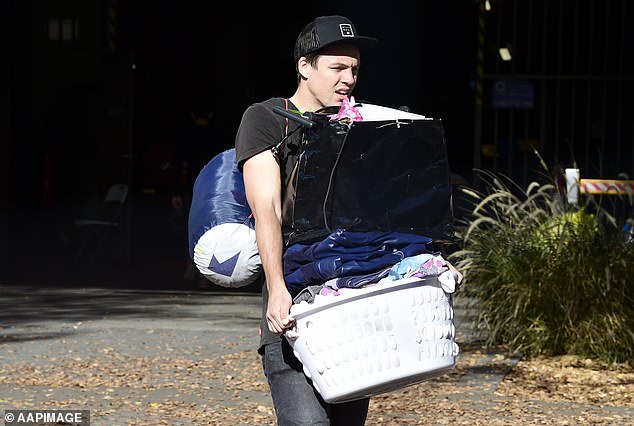Many Australians are coming to the realisation they will be living in apartments – rather than a house with a backyard – for the rest of their lives thanks to sky-high property prices.
And while there’s nothing wrong with raising a family in a flat, it definitely pays to do your research and make sure you’re not forking out a hundreds of thousands of dollars for a lemon.
Australia’s record-high immigration levels mean state governments are now overriding local councils and building high-rise residential towers near train stations, in a bid to boost housing supply and ease the affordability crisis.
Meanwhile, the Albanese government is falling short of its housing target of 240,000 new homes per year until 2029 – just 167,280 new homes were approved in the year to September 2024 – creating political pressure to ramp up building activity.
This increased pressure is only going to result in more apartments with more defects.
Strata law specialist Stephen Goddard says Labor’s political goals are a threat to future apartment owners.
‘The interests of the construction industry have become so aligned with the national economic interest that consumer protection is no more than roadkill in the corridors of government,’ he tells me.
‘Governments, both state and federal, have for generations seen the construction industry as a mechanism for economic stimulus creating employment and consumer activity.’

A resident being evacuated from Mascot Towers in Sydney

If you’re looking to spend about $650,000, you can become the owner of a small apartment in Sydney. Alternatively, you could buy a house interstate for the same amount and rent it out
The Albanese government’s target of building 1.2 million ‘well-located’ homes from 2024 to 2029 has never been achieved before. The closest was building 1.05 million between 2015 and 2020.
This coincided with the Opal Tower fiasco at Sydney Olympic Park in 2018 which saw residents evacuated from the brand new 392-apartment complex on Christmas Eve – just four months after completion.
Cracking walls were discovered and 3,000 residents from the 36-storey tower, and surrounding buildings, had to be evacuated. The developer, Icon, spent more than $42million relocating residents.
The Mascot Towers fiasco happened a year later, in 2019, leading to the evacuation of 132 households from an 11-year-old building also as a result of cracking in a complex near an underground train station.
Worryingly, more than half – or 53 per cent – of new apartment buildings had serious defects in 2023, up from 39 per cent in 2021, a Building Commission NSW report found.
That was based on residential blocks built over the past six years with poor waterproofing, fire safety, structural integrity, non-compliant cladding and problems with plumbing, lifts and electrical connections listed as the most common faults.
To be really safe, Mr Goddard advises his clients to avoid buying any apartment that has been built since private certifiers replaced council inspectors in 1998.

A building boom coincided with the Opal Tower fiasco at Sydney Olympic Park in 2018 which saw residents evacuated from the brand new 392-apartment complex on Christmas Eve – just four months after completion
‘I used to advise clients not to acquire a strata lot in a building newer than 10 years of age,’ he explains.
‘The conventional wisdom was that structural defects would expose themselves within that period.
‘On the evidence, structural defects are now occurring much later – giving rise to a conversation about whether this was a building defect or simply fair wear-and-tear.’
Mr Goddard says units built before 1998 are more likely to be free of serious faults.
‘Building defect issues did not exist pre-1998,’ he tells me.
‘In the old days, construction used to occur with the assistance of a “clerk of works” and the involvement of local government.
‘The clerk of works existed for the purpose of certifying to the client lender that progress payments could be made because the building code had been met to that point.’
The Opal and Mascot towers problems are far from the most common faults in new apartment buildings after private certifiers replaced council inspectors in New South Wales in 1998.
Robert Speirs-Ferrari, who has four decades’ experience as a building consultant inspecting for structural and waterproofing faults, says problems with apartment buildings typically occur after the seven-year structural warranty has expired.
‘Things don’t sort of happen until after the warranty period,’ he adds.
‘When you get up to 10 years, that’s when things start really going expensive on rectification of defects. There’s shoddy work.’
Shari Driver, the chief executive of the Owners Corporation Network, advises prospective apartment owners to only buy a unit that has been passed by the Independent Construction Industry Rating Tool – an industry body that gives star ratings to developers.
This enables apartment buyers to see how many stars out of five their unit builder was given.
Developers that fail to score a three-star gold rating or above, from ICIRT, are regarded as having quality issues and are reluctant to fix faults.
‘A low number of stars shows that the company or team exhibits higher risk or low-trust characteristics,’ it states.
Buyers of new apartment buildings are also advised to take out latent defect insurance which covers problems for 10 years.
‘Buying an apartment can still feel like a lottery,’ Ms Driver tells me.
‘It used to be that a million dollars would mean you were set for life.’
With quality-control problems, owners corporations are having to dig into their sinking funds to repair shoddy work.
‘These days, be ready for a million dollars more in repairs – payable by extra strata levies – if you buy from into a complex with serious defects,’ Ms Driver says.

Water ingress occurs when water makes its way into a building, causing problems from structural faults to mould
Here are some problems veteran building inspector Robert Speirs-Ferrari has observed in newer, high-rise apartments:
Water ingress
Water ingress occurs when water makes its way into a building, causing problems from structural faults to mould.
‘It’s to do with waterproofing membranes that go on to concrete slab balconies and also concrete slab roofs,’ Speirs-Ferrari says.
‘If you’ve got a flat concrete roof or concrete balconies and terraces and all those things, there’s got to be a waterproofing membrane put down.
‘If they put tiling over it, they’re the ones that have the problems with leakage and faulty work, and they’re very expensive to rectify.’
The Building Diagnosis Centre, which Mr Speirs-Ferrari runs, is currently helping to fix a unit block at Cammeray on Sydney’s lower north shore, with the owners’ corporation facing a repair bill of $250,000.

In newer buildings, balustrades are not bolted on properly to concrete balconies
Balcony balustrades not bolted on properly
In newer buildings, balustrades, particularly glass ones, are not being bolted on properly to concrete balconies.
In the worse-case scenario, a balustrade can fall over the balcony, threatening the safety of those below.
But in a high-rise apartment building, refitting the balustrading on hundreds of units can be very costly, leaving an owners corporation with a bill running into the tens of thousands of dollars.

Cracking in brick walls occurs when the builder hasn’t allow space for expansion joints (pictured is Mascot Towers in Sydney)
Cracking in walls
Cracking in brick walls occurs when the builder hasn’t allow space for expansion joints.
Thermal movement in soil, as a result of temperature changes, means that without these expansion joints – segmenting the wall into sections – cracking occurs.
‘There’s nowhere for the walls to move into a space so they will buckle and crack,’ Mr Speirs-Ferrari says.
Shrinkage cracking
Shrinkage cracking occurs when concrete or waterproofing hasn’t been allowed enough time to settle and cure.
This leads to cracking concrete on balconies or internal areas of a unit block.
‘So, they put the next stage of the work on top of it before it’s ready to be put on it – rushing to get the timeline done quickly,’ Mr Speirs-Ferrari tells me.

Foundations are often not installed deeply enough into the soil
Foundations not installed properly
Foundations are often not installed deeply enough into the soil. This problem is more common with houses rather than high-rise apartments, which require more extensive excavation to install piers with the expertise of geotechnical engineers.
‘Failing to dig the foundations properly, not making sure the soil or the clay is firm enough and compacted enough before they pour the concrete footings, is occurring,’ he says.
‘It may not be compressed properly and they just throw the concrete on top and that concrete will tend to want to settle in the soft spots.
‘It’s mainly residential housing, not so much with units and big buildings.’
Water can seep in around the foundations from the moisture in the soil.
If the water seepage is not diverted to flow down the side of the property, the foundations can be undermined.
‘The foundations are moving about, they’re resettling,’ Mr Speirs-Ferrari says.
‘If you resettle something, it means it’s uneven. That in turn causes cracking in the walls above.’
This differential cracking situation is more likely to occur on badly fitted foundations dug into soil but not rock.

Robert Speirs-Ferrari, who has more than four decades’ experience as a building inspector, says problems with apartment buildings typically occur after the seven-year structural warranty has expired – and blamed private certifiers replacing council inspectors
What has caused quality problems?
In late 1997, a first-term Labor government in New South Wales amended the Environmental Planning and Assessment Amendment Act so private certifiers instead of local council inspectors ensured building work complied with design requirements.
A new private certification scheme came into effect in July 1998, copying a system that had already existed in South Australia, Tasmania and the Northern Territory in a bid to speed up the construction process.
‘We never had this problem when the council inspectors were running around,’ Mr Speirs-Ferrari says.
‘They were very tough.’
Mr Spiers-Ferrari suspects developers are bribing private certifiers to approve their projects – but admits he has no proof of this.

Builders are now under more pressure to complete more apartments (pictured is a Sydney construction site)
Mr Speirs-Ferrari is concerned about a lack of proper supervision during various stages of building projects, which he puts down to inexperience.
‘It’s to do with the labour inexperience, not enough experience and not supervised,’ he explains.
‘Not inspecting the work at critical stages before the next series of different types of surface or work goes on.
‘You’ve got young engineers that come through the ropes that haven’t had enough experience and their employers put them out there to do an inspection and they sort of let things pass.
‘They’re nowhere near as good as the original council inspectors.’
NSW Better Regulation Minister Anoulack Chanthivong says has asked the Building Commission to audit private certifiers, telling me: ‘Audits of private and council certifiers by the Building Commission have found that performance standards across the entire industry need to lift.’
He adds the government is also considering introducing harsher penalties for certifiers who fail to declare links with developers.

NSW Better Regulation Minister Anoulack Chanthivong (left) said he had asked the Building Commission to audit private certifiers
‘The changes being considered would also introduce higher penalties for failure to abide by conflict-of-interest responsibilities and enhance the regulator’s power and capacity to audit certifiers’ work to prevent conflicts of interest,’ Chanthivong says.
But Spiers-Ferrari notes the pressure to finish more apartment towers is also putting the heat on existing certifiers, engineers and builders, compared with the era of council inspectors that existed until the late 1990s.
‘Buildings weren’t being put up so quickly [and] they were not so high-tech, whereas today materials and techniques have changed a bit so they’re a bit more complicated,’ he says.
The former NSW Coalition government introduced the Building and Development Certifiers Act 2018, a new accreditation system for private certifiers following a review by former public service boss Peter Shergold and legal consultant Bronwyn Weir.
NSW Labor last year updated regulations that will force builders to use the materials specified by an architect and not just a cheaper alternative.

Generally, it’s best to buy a unit in a suburb where there isn’t an oversupply of newly built high-rise apartment towers (pictured is a low-rise unit block in Sutherland that sold for $635,000)
What to buy
Generally, it is best to buy a unit in a suburb where there isn’t an oversupply of recently built high-rise apartment towers.
One-bedroom units are also much less likely to get capital growth, especially in a big apartment complex, because parents won’t want to raise children in them.
It’s also worth being aware of state government plans for more high-density living near train stations as this will increase the supply of units and reduce the price of existing stock in a suburb.
The Parramatta City Council area – covering Sydney Olympic Park with the Opal Tower – has a particularly high loss-making rate of 25 per cent, CoreLogic data shows.
That means one in four home sellers are making a loss – in an area where high-rise apartments are more prevalent.
But in the Sutherland Shire and the Northern Beaches, just 1.8 per cent of homes are sold at a loss. This is partly because high rises aren’t going up and so units in smaller, older blocks retain their value.
As a rule, two-bedroom units cost more in suburbs with more older, low-rise apartments, making them a wiser investment.
To illustrate this point, the median price for apartments at Waitara on Sydney’s upper north shore is $745,032.
This is well below greater Sydney’s mid-point apartment price of $864,018 – even though that part of the city is considered more upmarket.
But in neighbouring Wahroonga, just one suburb away, the median apartment price is $1.052million.
This suburb has more houses than units and the apartments near the train station are lower rise – as opposed to Waitara which typically has 11-storey tower blocks near the train station.
Nonetheless, there are still bargains to be hand, with a two-bedroom unit in Sutherland, 26km south-west of the Sydney CBD, selling for $635,000 in October.
That would be within the budget of an average, full-time worker earning $100,000 a year with a 20 per cent mortgage deposit.








